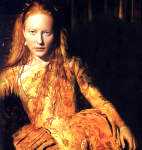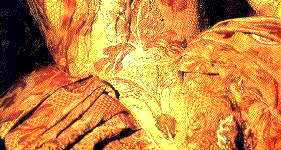Making of the bodice
Well, not much to say… I’ve just started making it with the ‚Lady’s wardrobe‘ patterns by Margo Anderson.
Here are a few pictures of the first test fitting:
| Back of the bodice lining, pinned together. It’s a bit too long – which I did intentionally, so I will have a longer front. However, I’ll have to shorten the back now, as the bottom – because of being too long – is wrinkling. As you can probably see, I have already marked where to cut off the excess material at the bottom back. The lining is made of *very* old, sturdy linen twill – a material I prefer over any other for lining. |
Front of bodice lining; the shoulder straps are of the dress material but will serve as lining (That’s why the left side of the fabric is to the outside in these pictures) (just because it’s so easy to look beneath the straps, and I want them to look good – even on the backside…). You can also see that I have already inserted the boning – flat steel boning, to be exact. The lining is still wrinkling a bit; but that will be solved when the bodice is properly side back laced (I can’t pin the lining so tight to the mannequin, because then the needles tend to slip out). |
| First test with the draped dress fabric over the above shown lining. It looks very nice, except that there’s still one wrinkle from left to right at the almost bottom of the bodice front. I’ll smooth that out when I sew the pieces together – because there’s nothing worse than horizontal wrinkles in an Elizabethan bodice… | Same as left, but this time from the side. Look how nice and straight the front is 🙂 Still the problem with that one wrinkle, though; but as I have already said – I’ll still be able to smooth that down without any problems when I sew the fabric to the lining. Beneath the lining, by the way, you can see my stays – that’s the white thing with the pink tabbed edges. It’s very important, if you test fit an Elizabethan garment on a dress mannequin, that this mannequin is wearing the appropriate underwear – meaning stays! Otherwise the garment would not fit – as seen with my embroidered jacket. |
And, just for fun and to control the result – compare so far:
Now – while first planning to do the golden netting overlay, I had to omit it. Here’s why:
As you can see, the golden netting only covers the areas between the patterns in the fabric – meaning just the lighter parts.
Alright, I sighed, and started sewing down the netting in just those places with a fine zigzag stitch – because, frankly, it looked a bit weird when the *whole* bodice was covered with netting – somewhat Halloween-ish.
(this picture was taken in the sun; you can see some shadow areas from my window frame in the picture)
That’s when I ran into problems.
As you can see in this picture – I’m exaggerating it a bit by forcing the cut netting ends to go up with my fingernail; something that would happen over time anyway when wearing the bodice – there was practically no way to sew the netting down in a way so that those fraying ends would at least stay in their seams: except if I would sew them over again and again – something that would have resulted in a very ‚quilted‘ look – something that wouldn’t have looked good on the gown.
Also, the netting somehow ‚disturbs‘ the pattern beneath it, so it was also not an option *not* to cut it. I think this can be seen in the following picture:
Plus, the netting feels scratchy; and as the sleeves are to be laced in – historically correct – and as I would then have a space in my armpit where my skin would get into direct contact with the scratchy material, I decided not to do the golden netting overlay.
Even if it might look somewhat nice – in bright light, as already mentioned, it looks cheap and Halloween-ish; plus, it’s scratchy and I can’t keep the edges from fraying and coming out of the seams.
So I pitied myself for a moment for wasting a whole afternoon on sewing down golden netting – and cut at least the front pattern piece anew from the fabric, because that’s the piece on which I tried to sew on the netting – and decided to make the bodice without the netting (and so I will do the doublet, sleeves and overskirt without the netting, too).
Afterwards I’ve sewn the bodice front together (both the outer pieces *and* the boned lining), and as I couldn’t let go of decoration, I decorated it with very few rhinestones. This is what it looked like when test pinned over the draped skirt:
As I’ve just written – the skirt is just draped, not sewn, so the folds don’t yet hang properly; but I think the picture shows very well how good and straight the front of the bodice looks, and how nice and deep the pointed front runs.
So happy with the result 🙂
And, yes, I know that those rhinestones decorations on the bodice are not really period for Elizabethan bodices. But I like it.
Plus, that’s my bodice, so I could decorate it with purple hologram stars if I wanted to, as long as I would like the result 😉
After making the forepart and sleeves, however, I thought it couldn’t hurt to add some more pearls to the bodice. This is what it looked like after this:
Now let’s go on to the second bodice – my doublet.


